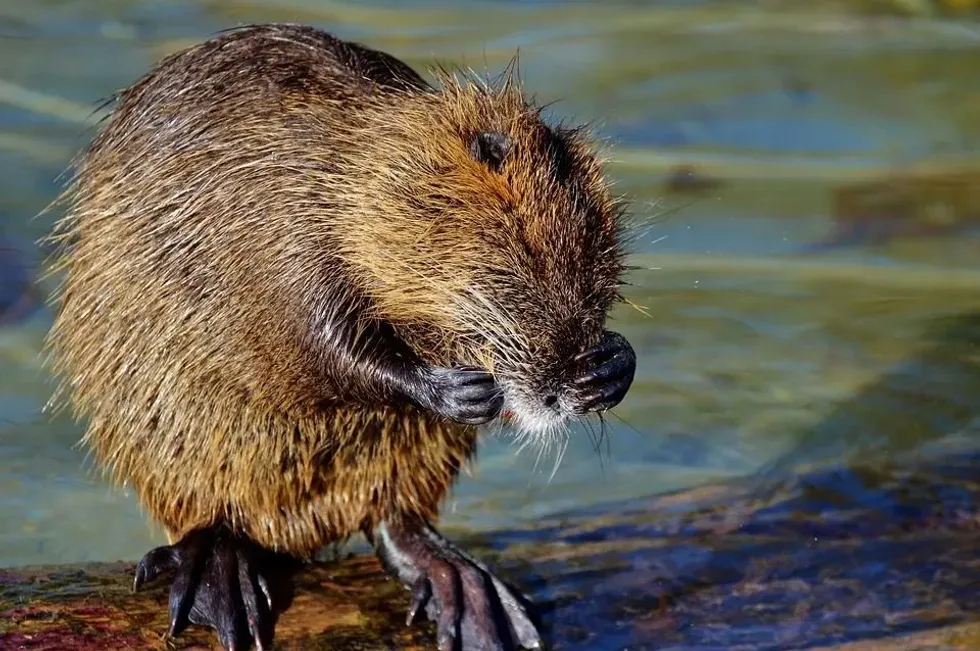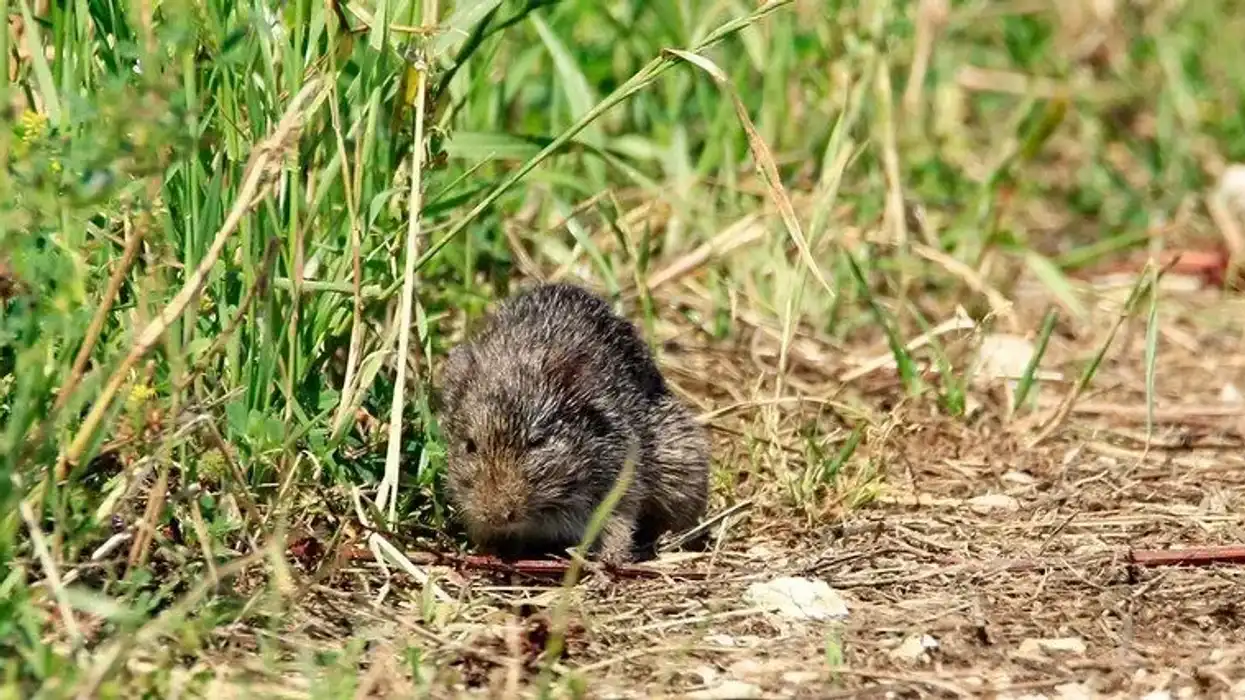The false water rat (Xeromys myoides) is a rodent that is native to Australia, particularly in southeast Queensland, New Guinea, and the northern territory. These rats have dark brown fur that slowly merges with white underparts.
They are small in size and reside in swampy regions of mangroves, coastal areas, and other such wetlands. They possess two molars on each half of their jaw and are bilaterally symmetrical animals.
These animals are nocturnal in nature and remain active throughout the night in search of food. These rats prey on crustaceans like crabs, worms, insects, and even certain vertebrates like lizards and fish.
The false water rat is considered to be a vulnerable species as its population is highly threatened due to a loss of habitat and predators like foxes, pigs, and dingoes. Little is known about the reproductive behavior of this rat species, but it is known that they form nests in between the roots of mangrove trees and sedge lands.
These nests are built of mud and leaves, which are similar to that of termite mounds.
If you liked reading this article, then do check out these gerbil facts and marsupial mole facts.
False Water Rat Interesting Facts
What type of animal is a false water rat?
The false water rat (Xeromys myoides) is a nocturnal rodent that belongs to the Muridae family.
What class of animal does a false water rat belong to?
The false water rat that is found in mangrove communities is a mammal.
How many false water rats are there in the world?
Although the exact number of false water rats is not recorded, this group of rats is known to be vulnerable, and thus, their population is threatened.
Where does a false water rat live?
False water rats (Xeromys myoides) are native to Australia, particularly in southeast Queensland and the northern territory. They are also known to inhabit North Stradbroke Island and New Guinea.
What is a false water rat's habitat?
The false water rat species resides in mangrove forest regions, coastal regions, and other wetlands. Their distribution is widely seen in swamp communities, freshwater lagoons, and sedged lakes.
Who do false water rats live with?
Although the false water rat is solitary by nature, it is known to share its nest with other rat members due to the interlinked tunnels present in its nest. This particular characteristic leads to their social and friendly behavior. Usually, a single male rat resides with a number of females and juveniles.
How long does a false water rat live?
The water rat is known to live for up to two years in the wild. Their life depends upon the availability of mangrove forest habitats, and hence, conservation of these mangroves is essential.
How do they reproduce?
The false water rat (Xeromys myoides) partakes in sexual reproduction and internal fertilization, just like other mammals. Although little is known regarding the reproduction of this rat species, it is known that their litter size is only two, and they develop their babies in mud nests that look like termite mounds.
They are dioecious like the deer mouse. Their gestation period is recorded to last for about 30 days and this species is known to breed throughout the year.
What is their conservation status?
The IUCN (International Union for Conservation of Nature) Red List has listed the false water rat (Xeromys myoides) as a Vulnerable species group. Their population is highly threatened due to large-scale mangrove deforestation that is leading to habitat loss and the existence of predators like foxes, pigs, and dingoes.
A project involving the immediate protection of swamp habitats is needed in order to conserve this species.
False Water Rat Fun Facts
What do false water rats look like?
The false water rat (Xeromys myoides) has a dark brown body. Their head is flattened and they possess small rounded ears. This water rat species has tiny black small eyes and a long brown tail within the range of 3.34-3.93 in (8.5-10 cm).
These mammals reside in groups in their swamp nests. Their average hind foot length is about 0.9-1.02 in (2.3-2.6 cm). This species has two molars in each part of its jaw and bears yellowish-orange upper incisors and white lower incisors.
Their body fur is smooth and water-resistant. They actively gather food at night time like bats. They have a bilaterally symmetrical body with white underparts, and their feet are not webbed.
 *We've been unable to source an image of a false water rat and have used an image of a beaver rat instead. If you are able to provide us with a royalty-free image of a false water rat, we would be happy to credit you. Please contact us at hello@kidadl.com
*We've been unable to source an image of a false water rat and have used an image of a beaver rat instead. If you are able to provide us with a royalty-free image of a false water rat, we would be happy to credit you. Please contact us at hello@kidadl.com
How cute are they?
The false water rat that is found in mangrove habitats is quite cute due to its small body size and tiny ears.
How do they communicate?
Australian false water rats communicate by tactile perceptions. They are highly active and motile animal species like the American harvest mouse. They also communicate through the perception of chemical smells.
How big is a false water rat?
The average false water rat size is about 4.5-4.9 in (11.5-12.5 cm) and this is bigger than the size fo the American harvest mouse, which can range from around 2.2-3.1 in (5.6-7.8 cm) in length.
How fast can a false water rat move?
Water rats do not have webbed feet. Due to this type of foot, they do not have the capability to swim in water.
Though their exact speed is not known, the false water rat is a pretty quick runner thanks to its small body size and it can escape from sudden dangers quickly, just like other mice and rats. The harvest mouse is known to possess a speed of 8 mph (12 kph).
How much does a false water rat weigh?
The Australian false water rat (Xeromys myoides) has a weight range of about 0.08-0.13 lb (36-56 g).
What are the male and female names of the species?
The false water rat (endangered species) possesses specific names. The female of the group is called a doe, while male rats are called bucks.
What would you call a baby false water rat?
A false water rat baby that resides in an Australian habitat is called a pup or a nestling.
What do they eat?
The typical false water rat diet includes crustaceans like crabs, worms, insects, and even certain vertebrates like lizards and fish. They forage among mangrove trees in coastal regions in other wetlands.
Are they dangerous?
This rat species with an Australian habitat is not dangerous and does not pose any threat to humans. They are active animals in their coastal habitat and in wetlands. The species is threatened by humans and predators.
Would they make a good pet?
These rats can make good pets if they are provided with proper care. They are known to be social creatures if not threatened. However, the species is nocturnal and actively searches for food at night. Thus, they prefer coastal land and swampy land and will thrive best in the wild.
Did you know...
False water rats are known to cover 1.8 mi (2.9 km) every night for foraging. They are known to build their nest using crab shells and leaves and these nests have only a single entrance.
Just like other mammals, rats lactate for their babies after giving birth. During the lactation period, a low amount of adrenal hormones are secreted in their body. The baby rat is nursed and breastfed by its mother. The mother's milk provides them with all the vital nutrients.
A rat's tail is quite important. They are known to expand their tails' length, which helps them in regulating their body temperature.
In some northwest Indian regions, rats are worshipped as deities.
Just like mice, rats are vectors of deadly pathogens and they can spread a number of diseases, like plagues.
Rats' teeth are known to grow as large as 5 in (12.7 cm) every year, this helps them as they gnaw on sharp objects.
Rats are highly playful and can produce high-pitched calls that sound like chuckles.
How did the false water rat get its name?
The false water rat does not have webbed feet and thus, is not capable of swimming. Therefore, they are known to search for food in coastal and wetland areas instead of diving into the water. However, they look similar to the Australian rodent species, the true water rat (Hydromys chrysogaster). So, they are called false water rats.
Are water rats a protected species?
The population trend of this species is decreasing and water rats were previously poached for their lustrous fur. Now, these threatened rats are a protected species in Australia.
Here at Kidadl, we have carefully created lots of interesting family-friendly animal facts for everyone to discover! For more relatable content, check out these black rat facts and nutria facts for kids.
You can even occupy yourself at home by coloring in one of our free printable mouse sleeping coloring pages.
*We've been unable to source an image of a false water rat and have used an image of a beaver rat instead. If you are able to provide us with a royalty-free image of a false water rat, we would be happy to credit you. Please contact us at hello@kidadl.com




 *We've been unable to source an image of a false water rat and have used an image of a beaver rat instead. If you are able to provide us with a royalty-free image of a false water rat, we would be happy to credit you. Please contact us at hello@kidadl.com
*We've been unable to source an image of a false water rat and have used an image of a beaver rat instead. If you are able to provide us with a royalty-free image of a false water rat, we would be happy to credit you. Please contact us at hello@kidadl.com




